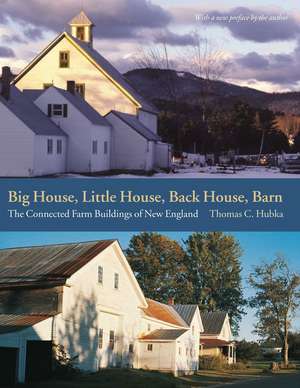Big House, Little House, Back House, Barn: The Connected Farm Buildings of New England
Autor Thomas C. Hubkaen Limba Engleză Paperback – 30 ian 2023
Big House, Little House, Back House, Barn portrays the four essential components of the stately and beautiful connected farm buildings made by nineteenth-century New Englanders that stand today as a living expression of a rural culture, offering insights into the people who made them and their agricultural way of life. A visual delight as well as an engaging tribute to our nineteenth-century forebears, this book, first published nearly forty years ago, has become one of the standard works on regional farmsteads in America. This new edition features a new preface by the author.
Preț: 211.19 lei
Nou
Puncte Express: 317
Preț estimativ în valută:
40.41€ • 42.31$ • 33.52£
40.41€ • 42.31$ • 33.52£
Carte disponibilă
Livrare economică 20 martie-03 aprilie
Livrare express 05-11 martie pentru 64.24 lei
Preluare comenzi: 021 569.72.76
Specificații
ISBN-13: 9781684581351
ISBN-10: 1684581354
Pagini: 252
Ilustrații: 134 halftones and line drawings
Dimensiuni: 216 x 279 x 18 mm
Greutate: 0.7 kg
Ediția:Nouă
Editura: Brandeis University Press
Colecția Brandeis University Press
ISBN-10: 1684581354
Pagini: 252
Ilustrații: 134 halftones and line drawings
Dimensiuni: 216 x 279 x 18 mm
Greutate: 0.7 kg
Ediția:Nouă
Editura: Brandeis University Press
Colecția Brandeis University Press
Recenzii
Praise for the previous edition:
"An unexpected small masterpiece that has some of the suspense of a detective story and, at times, the poignance of deeply felt, sympathetic social history."--Robert Campbell, Boston Globe
"An unexpected small masterpiece that has some of the suspense of a detective story and, at times, the poignance of deeply felt, sympathetic social history."--Robert Campbell, Boston Globe
Praise for the Previous Edition:
"An important pioneering effort. The book commemorates both an unique indigenous architectural expression and a way of life that has become extinct . . . The style is economic and clear and Hubka's affection for architecture binds the buildings to their people and their times."
"An important pioneering effort. The book commemorates both an unique indigenous architectural expression and a way of life that has become extinct . . . The style is economic and clear and Hubka's affection for architecture binds the buildings to their people and their times."
Praise for the Previous Edition:
"No matter where you live, you will want this book as a model of vernacular architecture scholarship."
"No matter where you live, you will want this book as a model of vernacular architecture scholarship."
Notă biografică
Thomas C. Hubka is professor emeritus in the Department of Architecture and Urban Planning at the University of Wisconsin–Milwaukee. In 2006 he received the Vernacular Architecture Forum’s Henry Glassie Award in recognition of his lifetime of achievement. His most recent book is How the Working-Class Home Became Modern, 1900–1940.
Cuprins
Acknowledgments
Introduction to the New Edition
Preface
Preface to the Twentieth-Anniversary Edition
I. CONNECTED FARM BUILDINGS
1. Appearance and Actuality
II. PATTERN IN CONNECTED FARM BUILDINGS
2. The Buildings
3. The Buildings and the Land
4. Permanence and Change
5. Pattern in Building and Farming
III REASONS FOR MAKING CONNECTED FARM BUILDINGS
6. Tobias Walker Moves His Shed
7. Why Tobias Walker Moved His Shed
Notes
Bibliography
Glossary
Index
Figure Credits
Introduction to the New Edition
Preface
Preface to the Twentieth-Anniversary Edition
I. CONNECTED FARM BUILDINGS
1. Appearance and Actuality
II. PATTERN IN CONNECTED FARM BUILDINGS
2. The Buildings
3. The Buildings and the Land
4. Permanence and Change
5. Pattern in Building and Farming
III REASONS FOR MAKING CONNECTED FARM BUILDINGS
6. Tobias Walker Moves His Shed
7. Why Tobias Walker Moved His Shed
Notes
Bibliography
Glossary
Index
Figure Credits
